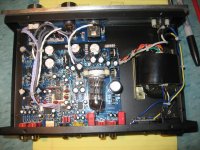UF4007. Cheap and quieter.
One of my favorites, and cheap and easy to find.
Thanks a lot, guys! I heard Schottky diodes are also good. How do they compare with the UF4007 and BY399?
I can't tell the difference between a UF4007 and a high voltage Schottky at many times the price, although there are those who claim to be able to.. Might have something to do with the way I design things.. Or perhaps my tin ears?
I happened to chance upon what looks to be a very good rectifier. Have you heard about or tried the NTE575? It's faster than the UF4007 (TRR is 70 ns compared to 75 ns for the UF4007) and it has lower forward voltage (VF is 1.5V compared to 1.7V for the UF4007). It's three times more expensive though, 70 cents a piece. Do you think it is good and worth the higher price compared to UF4007?
One more question -- and I hope you don't get tired of my newbie stuff-- can I replace a 1N4001 with a UF4007? If so, is UF4007 going to work better than UF4001 as replacement for 1N4001?
Thanks!
Yes you can.
Will it work better... not necessarily... depends on the application.
One more question -- and I hope you don't get tired of my newbie stuff-- can I replace a 1N4001 with a UF4007? If so, is UF4007 going to work better than UF4001 as replacement for 1N4001?
Thanks!
yes you can, and no it doesn´t work better. the number (7) is just the voltage area descriptor.
cheers Uli



Yes you can.
Will it work better... not necessarily... depends on the application.
yes you can, and no it doesn´t work better. the number (7) is just the voltage area descriptor.
cheers Uli
Good to know! Thanks a lot, guys!!!
Finally, I ordered the UF4007 diodes and have received them. Before I put them in, I'd like to know if the performance can be improved further by bypassing each UF4007 diode with a 0.01 uF polyester or polypropylene cap. I just read about some people doing this. I happen to have some spare 0.01 uF caps around and thought I could use them. What do you think?
Now, instead of a simple capacitor, some people are using an RC snubber -- I guess this is a resistor in series with a capacitor -- but this requires one to make measurements to determine the problem frequencies in order to calculate the appropriate R and C values to use. I do not have a scope to be able to do this, though. But if this is a better approach and if someone could suggest R and C values to use that would be the norm in most linear power supply designs, it would be most appreciated.
On the other hand, I wonder if I'm overthinking this. Do I really need these additional things considering the already good performance of the UF4007 by itself?
Thanks!
Now, instead of a simple capacitor, some people are using an RC snubber -- I guess this is a resistor in series with a capacitor -- but this requires one to make measurements to determine the problem frequencies in order to calculate the appropriate R and C values to use. I do not have a scope to be able to do this, though. But if this is a better approach and if someone could suggest R and C values to use that would be the norm in most linear power supply designs, it would be most appreciated.
On the other hand, I wonder if I'm overthinking this. Do I really need these additional things considering the already good performance of the UF4007 by itself?
Thanks!
On the other hand, I wonder if I'm overthinking this.
Probably.
Try simple first- if the diodes aren't throwing noise into the system, stop, do not pass go, do not collect $200. Sit back and enjoy the music.
Probably.
Try simple first- if the diodes aren't throwing noise into the system, stop, do not pass go, do not collect $200. Sit back and enjoy the music.
The thing is, I don't have a scope that would allow me to measure any noise that the diodes might be throwing. Anyway, the first option of putting a 0.01 uF bypass cap is so simple, I think I want to do it. Hopefully, it might improve the performance. Even if it doesn't improve it, as long as it doesn't hurt either, I'm OK with that. So, do you think it will NOT hurt at all to put a 0.01 uF bypass cap and the worst that could happen is no improvement?
Last edited:
It's unlikely to hurt anything and is pretty commonly done.
Thanks, I'll do it then. BTW, is it also commonly done even with good diodes like UF4007?
I'd just use 1N400x's with a cap DIRECTLY (with leads between the diode and cap as short as possible) across each one. I've heard of instances where the 1N400x's in a power supply can cause some buzzing in the circuit (I vaguely recall something about some RF oscillation when it switches on or off), and putting the caps in quiets that source. The UF parts might well be 'better' in perhaps not generating such noise to start with, but the caps should stop it regardless.
- Status
- This old topic is closed. If you want to reopen this topic, contact a moderator using the "Report Post" button.
- Home
- Design & Build
- Parts
- Help me find a better sub for 1N4007
